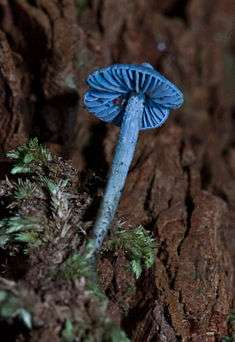Entoloma hochstetteri
| Entoloma hochstetteri | |
|---|---|
 | |
| Scientific classification | |
| Kingdom: | Fungi |
| Division: | Basidiomycota |
| Class: | Agaricomycetes |
| Subclass: | Hymenomycetes |
| Order: | Agaricales |
| Family: | Entolomataceae |
| Genus: | Entoloma |
| Species: | E. hochstetteri |
| Binomial name | |
| Entoloma hochstetteri (Reich.) Stev. | |
| Entoloma hochstetteri | |
|---|---|
|
| |
| gills on hymenium | |
| cap is convex | |
| hymenium is adnate | |
| stipe is bare | |
| spore print is pink | |
| edibility: unknown | |
Entoloma hochstetteri is a species of mushroom found in New Zealand and India. The small mushroom is a distinctive all-blue colour, while the gills have a slight reddish tint from the spores. The blue coloring of the fruit body is due to three azulene pigments.[1] Whether Entoloma hochstetteri is poisonous or not is unknown.
The Māori name for the blue mushroom is werewere-kokako because the colour is similar to the blue wattle of the kōkako bird.[2]
This species was one of six native fungi featured in a set of fungal stamps issued in New Zealand in 2002.[3][4]
Taxonomy

The species was first described as Hygrophorus hochstetteri in 1866 by the Austrian mycologist Erwin Reichardt, before being given its current binomial name in 1962 by Greta Stevenson. It is named after the German naturalist Ferdinand von Hochstetter.
Description
Entoloma hochstetteri has a small delicate epigeous (above-ground) fruiting body (basidiocarp) which may be found among moss or leaf litter. The cap may be up to 4 cm (1.4 in) in diameter and conical in shape. The cap color is indigo-blue with a green tint, and is fibrillose. The cap margin is striate and rolled inwards. The gill attachment is adnexed or emarginate, gills are thin and 3–5 mm wide, essentially the same color as the cap, sometimes with a yellow tint. The cylindrical stipe is up to 5 cm (2 in) long by 0.5 cm thick, fibrillose and stuffed. The spore print is reddish-pink. The spores are 9.9–13.2 by 11.8–13.2 μm, tetrahedric in shape, hyaline, smooth and thin-walled. The basidia are 35.2–44.2 by 8.8–13.2 µm, club-shaped, hyaline, and with two or four sterigmata.[5]
Distribution
Entoloma hochstetteri grows in woodlands of western parts of both the North and South Islands of New Zealand,[6] where it is associated with Nothofagus and Podocarpus species. It has also been found in India.[5]
Toxicity
Although many members of the genus Entoloma are poisonous, the toxicity of this species is unknown. It has been investigated to see if its blue colouring might be manufactured as a food dye.[7]
See also
References
- ↑ Gill M. (2003). "Pigments of fungi (Macromycetes)". Natural Product Reports. 20 (6): 615–39. doi:10.1039/b202267m. PMID 14700203.
- ↑ "Science:Mushroom might yield major value". Retrieved 21 Dec 2016.
- ↑ Moss MO, Pegler DN. (2003). Recent stamp issues of fungi from New Zealand. Mycologist 17:176-178.
- ↑ "WNS: NZ008.02 (Native fungi - Entoloma hochstetteri)". Retrieved 2008-11-14.
- 1 2 Dhancholia S. (1989). "Entoloma hochstetteri (Agaricales) - a new record from India". Current Science 58(3): 146–7.
- ↑ Hongo T. (1990). "New and Noteworthy agarics from New Zealand". Reports of the Tottori Mycological Institute. 28: 129–34.
- ↑ Gates, Charlie. "Mushroom might yield major value". Stuff.co.nz. Stuff. Retrieved 1 May 2016.
External links
| Wikispecies has information related to Entoloma hochstetteri |
| Wikimedia Commons has media related to Entoloma hochstetteri. |
- More information via Landcare Research New Zealand Ltd
- Entoloma hochstetteri discussed on RNZ Critter of the Week, 2 December 2016